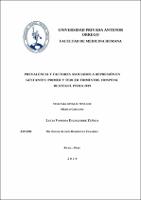Prevalencia y factores asociados a depresióin en gestantes: primer y tercer trimestre. Hospital Reategui. Piura 2019

Ver/
Descargar
(application/pdf: 1.117Mb)
(application/pdf: 1.117Mb)
Fecha
2019Autor(es)
Eyzaguirre Zuñiga, Lucía Vanessa
Metadatos
Mostrar el registro completo del ítemResumen
La depresión durante el embarazo afecta tanto a la embarazada como al feto en tanto la falta de sueño, la hiporexia y el pensar en auto eliminarse comprometen la salud y la vida de madre e hijo. No se ha estudiado tanto si la depresión varía en los diferentes trimestres del embarazo y su asociación con factores sociales en nuestra región. OBJETIVO. Determinar la prevalencia y factores asociados a depresión en gestantes durante el primer y tercer trimestre de embarazo. MATERIAL Y MÉTODO. Estudio observacional, transversal, prospectivo, de fuente primaria. La población fue todas las gestantes mayores de edad, que acudieron a los consultorios de gineco obstetricia del Hospital II-1 “Jorge Reátegui Delgado” durante Enero - Mayo 2019, y que cumplieron los criterios de selección. El muestreo fue no probabilístico, por conveniencia y por saturación. A 117 gestantes en el primer trimestre de gestación y 117 en su tercer trimestre se les aplicó el test de Edimburgo validado para gestantes y puérperas. RESULTADOS. 41.9% tuvieron algún nivel de depresión; 22.2% estaban en riesgo de tener depresión y 35.39% no tenía depresión ni estaba en riesgo de tenerla. CON DEPRESIÓN el 37.6% de las que estaban en su primer trimestre y el 46.2% de quienes estaban en su tercer trimestre. La diferencia no es estadísticamente significativa. Factores de riesgo para depresión durante el embarazo: Antecedente de depresión en algún momento de su vida; antecedente de violencia y consumo de alcohol. Factores protectores: Embarazo planificado, trabajo estable. Depression during pregnancy affects both the pregnant woman and the fetus, while lack of sleep, hyporexia and thinking about self-elimination compromise the health and life of mother and child. It has not been studied so much whether depression varies in the different trimesters of pregnancy and its association with social factors in our region. AIM. To determine the prevalence and factors associated with depression in pregnant women during the first and third trimesters of pregnancy. MATERIAL AND METHOD. Observational, cross-sectional, prospective study of primary source. The population was all pregnant women of legal age, who attended the gynecological obstetrics offices of Hospital II-1 “Jorge Reátegui Delgado“ during January- July 2019 and who met the selection criteria. The sampling was non-probabilistic, for convenience and saturation. A 117 pregnant women in the first trimester of pregnancy and 117 in their third trimester were administered the validated Edinburgh test for pregnant and puerperal women. RESULTS 41.9% had some level of depression; 22.2% were at risk of having depression and 35.39% had no depression or were at risk of having depression. WITH DEPRESSION 37.6% of those who were in their first quarter and 46.2% of those who were in their third quarter. The difference is not statistically significant. Risk factors for depression during pregnancy: History of depression at some point in your life; history of violence and alcohol consumption. Protective factors: Planned pregnancy, stable work.
Colecciones
- Medicina Humana [3015]

